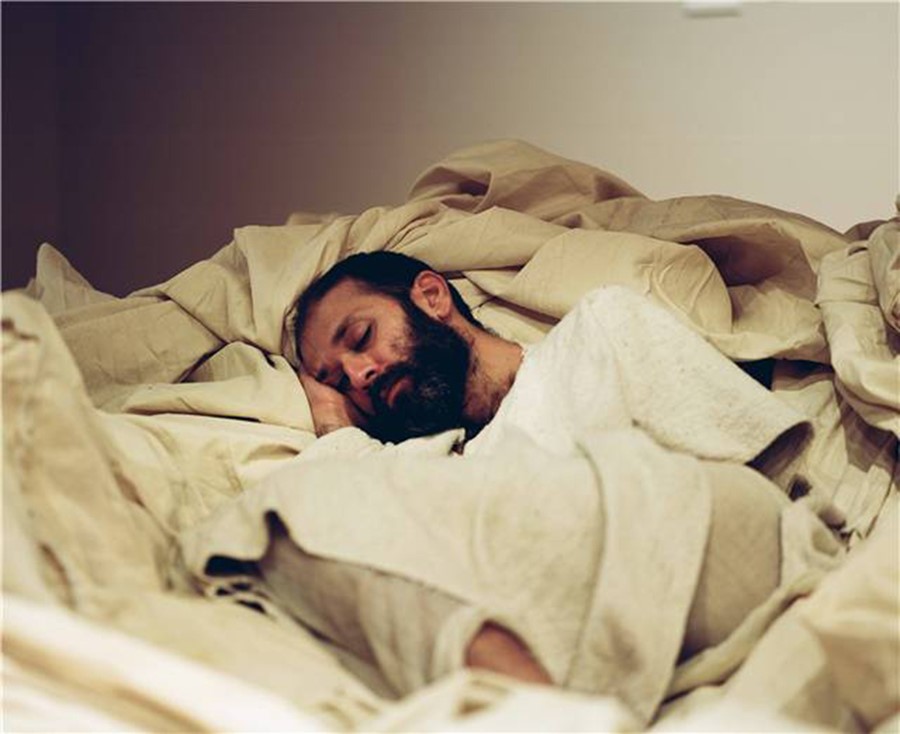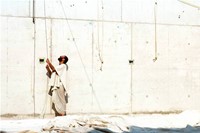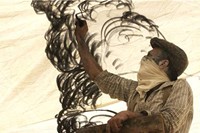Speaking from the beautiful 200-year-old house where he is currently living in Goa, performance artist Nikhil Chopra talks about slowing down, vulnerability in his performances, and how his grandfather is his inspiration.
It’s difficult to explain how much, and how little, happens during a performance by Indian artist Nikhil Chopra. Known for his feats of endurance – one performance lasted 99 hours – his actions, allusions, and the stories he unfolds seem to span cultures, sentiments, and centuries. Recently he was invited by the Whitworth Art Gallery for his second Manchester International Festival performance (the first was in 2009), this time exploring the city’s history of cotton manufacturing, which had brought it prosperity in the 19th century. The performance, Coal on Cotton, started out with Chopra dragging 250 kilos of unbleached calico through the gallery, then, over the next 65 hours, silently inhabiting three personas, a farmer, a mill worker, and a mill owner, with the gallery staying open to visitors from sunrise on Friday, to sunset on Sunday. Chopra first erected a tent out of the calico, which encompassed a partially-done wing of the gallery’s new extension, and which saw visitors at all hours of the day and night watching him eat, sleep, move around, and eventually create an enormous landscape drawing on the tent wall in charcoal. Speaking from the beautiful 200-year-old house where he is currently living in Goa, Chopra – who is from Kashmir, studied in Ohio, and lived in both New York and Berlin – talks about slowing down, vulnerability in his performances, and how his grandfather is his inspiration.
Your performances seem to be a lot about slowness, which may be surprising for people who are used to a more immediate payoff when it comes to art.
That’s precisely what I want to do, play with people’s expectations. With my performances it’s not just about slowing down, it’s about slowing down to the extent that there is almost a reversal, a way to think back to the ways we thought about time, and the ways we thought about making an image. It used to take days and months and even years for a painter to make even one picture, whereas now we’re in this instant world.
Modernism naturally tends to the idea of giving us things at a faster and faster speed. In our daily lives we find ourselves so caught in the flow of this high speed highway, that firstly, disconnecting myself from this world – the internet, the telephone, family, relationships – everything that I ordinarily connect to, is in itself the performance, it’s the deliberate act of doing something that’s against the normal flow of the body. Also, during the performance, the audience’s breathing slows down too, and we start to observe things about ourselves that we don’t ordinarily do.
"My performance is the deliberate act of doing something that’s against the normal flow of the body"
Do you feel vulnerable when performing?
Yes I do. Although, I’ve gotten used to this kind of vulnerability, and I find myself in situations often falling asleep now. But it’s those moments when I’m awake and I have my eyes closed and I’m trying to sleep that I feel more vulnerable, or those real crises when I’m exhausted after putting myself through something extremely tiring like putting the tent up; those are also moments of vulnerability because my mind is playing a lot of tricks on me at that point.
But there are also moments of trust that have to kick in if one is to see oneself through the performance. I have to believe in myself, and I have to believe in the desire in the eyes of the audience to see me through – to psychologically carry me through and keep that fire burning no matter how hard it is. Because there is a threshold I will cross and a feeling of exhalation that will come from it, which I hope will also be experienced by the audience.
Which characters were you invoking for Coal and Cotton?
There were three personas. I hesitate to call them characters because they are so much an extension of me, and I don’t see myself playing anything outside of myself, so the first was a farmer, very rudimentarily dressed, and he’s the guy that pushes all that fabric through the gallery as if he is wrestling the landscape. Once the tent went up I transformed into what would resemble a late 19th century-early 20th century mill worker from Lancashire, and it was this worker that dominated the performance, he was the backbone; he was the one who made the landscape drawing on the wall.
Then on Sunday when the landscape drawing is done, he transforms into this flamboyant flâneur, with a green jacket and white hat. He’s the mill owner, land owner, nobleman, and he orders four construction workers to bring the tent down, drag it through the gallery, and reinstall the drawing at the front of the building. So this boss stands there posing in front of the drawing as though he were not just the owner of the mill or the drawing, but also the Whitworth Gallery, also Manchester, also England.
You’ve said that your grandfather inspires your work. How so, and is that a photo of him on the front of your website?
Yes, that’s my grandfather and his German girlfriend at the time at the train station. He is a huge inspiration for me. A lot of the performances I have done before this were loosely based on him. He studied at Goldsmiths in London and then moved back to be a commercial artist in Kashmir. He spent most of his life making illustrations of refrigerators and soaps and toothpaste, and ran a little printing press. Then when he retired, he made these beautiful landscapes of Kashmir that became the inspiration for the landscape drawings that I create in my performances.
Is it difficult to endure such long performances?
I do pamper myself as well. I make myself very comfortable, and there’s always a really nice mattress for me to have a lie down on, and a super meal for me that is part of the setting. For, Inside Out, in Italy, it was prosciutto and fresh summer fruit and great wine, so I’m playing with decadence as well. For Coal and Cotton, I wasn’t afraid to luxuriate in the 500 metres of fabric that I had ordered from India. I sank into it and had this nice long comfortable nap that then gave me the energy to go on. So, much of the time, I’m mostly going "wow" in these situations.
Nikhil Chopra will be returning to the UK in November with a new performance for the Shakti Festival of Arts.
Text by Ananda Pellerin
Ananda Pellerin is a London-based writer and regular contributor to anothermag.com



